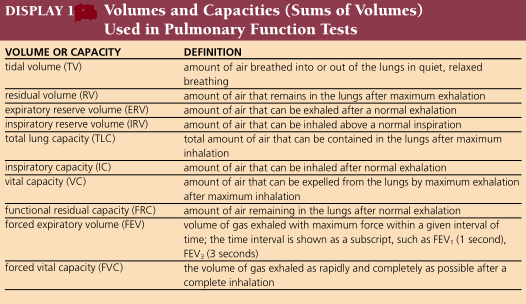In addition to chest radiographs, CT scans, and magnetic resonance imaging (MRI) scans, methods for diagnosing respiratory disorders include lung scans, bronchoscopy, and tests of pleural fluid removed by thoracentesis. Arterial blood gases (ABGs) are used to evaluate gas exchange in the lungs by measuring carbon dioxide, oxygen, bicarbonate, and pH in an arterial blood sample. Pulse oximetry is routinely used to measure the oxygen saturation of arterial blood by means of a simple apparatus, an oximeter, placed on a thin part of the body, usually the finger or the ear.
Pulmonary function tests are used to assess breathing, usually by means of a spirometer. They measure the volumes of air that can be moved into or out of the lungs with different degrees of effort. Often used to monitor treatment in cases of allergy, asthma, emphysema, and other respiratory conditions, they are also used to measure progress in cessation of smoking. The main volumes and capacities measured in these tests are given in Display 1. A capacity is the sum of two or more volumes.

责任编辑:admin
上一篇:医学文章阅读——Preoperative Testing in a Patient With Asthma
下一篇:医学文章阅读——Cystic Fibrosis

微信公众号搜索“译员”关注我们,每天为您推送翻译理论和技巧,外语学习及翻译招聘信息。